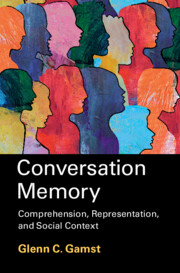
-
Select format
-
- Publisher:
- Cambridge University Press
- Publication date:
- October 2025
- October 2025
- ISBN:
- 9781009626095
- 9781009626088
- 9781009626057
- Dimensions:
- (229 x 152 mm)
- Weight & Pages:
- 0.557kg, 276 Pages
- Dimensions:
- (229 x 152 mm)
- Weight & Pages:
- 0.401kg, 276 Pages
You may already have access via personal or institutional login
Book description
Understanding how conversation is produced, represented in memory, and utilized in daily social interaction is crucial to comprehending how human communication occurs and how it might be modeled. This book seeks to take a step toward this goal by providing a comprehensive, interdisciplinary overview of conversation memory research and related phenomena that transcends the foundations of cognitive psychology. It covers a wide range of conversation memory topics, including theoretical approaches, representation in long-term memory, gender, race, and ethnicity effects, methodological issues, conversation content, social cognition, lifespan development, nonverbal correlates, personality and individual differences, disability, and conversation memory applications. Featuring new content reflecting the historical development of the conversation memory field alongside an extensive reference list, the book provides a complete, single-source reference work for conversational remembering research that should be of interest across disciplines.
Reviews
‘This book provides an historical account of the study of conversations. The scope of the text is broad, addressing relevant research on conversations across a wide range of topics in psychology – both basic and applied. Conversation is the heart and soul of human experience, and Gamst's work captures this.'
Kathy Pezdek - Professor of Psychology, Claremont Graduate University, USA Source: 2025
‘How we encode, store, and use information from conversation is an understudied topic across disciplines. In Conversation Memory, Gamst takes what has been historically siloed cross-disciplinary literature and produces a coherent and timely work that will be of great value to anyone interested in the understanding of conversation.'
Andrew J. Guydish - Assistant Professor of Psychology, University of La Verne, USA
‘Although it is hard to believe that it has been over 40 years since the inception of this book, it is not difficult to believe that it is a labor of love. With that said, I think that this book will be valuable to both current and early career researchers in the area of memory for conversation for several reasons. Advanced scholars can make use of the extensive list of references and the summaries of research and theory outside their areas of expertise. Students and researchers at the start of their careers will find it useful for those same reasons, but also for the description of theoretical controversies and areas of future research.’
Joel S. Freund Source: Associate Professor Emeritus, University of Arkansas
Contents
Metrics
Altmetric attention score
Full text views
Full text views help Loading metrics...
Loading metrics...
* Views captured on Cambridge Core between #date#. This data will be updated every 24 hours.
Usage data cannot currently be displayed.
Accessibility standard: WCAG 2.1 AA
Why this information is here
This section outlines the accessibility features of this content - including support for screen readers, full keyboard navigation and high-contrast display options. This may not be relevant for you.
Accessibility Information
The PDF of this book complies with version 2.1 of the Web Content Accessibility Guidelines (WCAG), covering newer accessibility requirements and improved user experiences and achieves the intermediate (AA) level of WCAG compliance, covering a wider range of accessibility requirements.
Content Navigation
Table of contents navigation
Allows you to navigate directly to chapters, sections, or non‐text items through a linked table of contents, reducing the need for extensive scrolling.
Index navigation
Provides an interactive index, letting you go straight to where a term or subject appears in the text without manual searching.
Reading Order and Textual Equivalents
Single logical reading order
You will encounter all content (including footnotes, captions, etc.) in a clear, sequential flow, making it easier to follow with assistive tools like screen readers.
Short alternative textual descriptions
You get concise descriptions (for images, charts, or media clips), ensuring you do not miss crucial information when visual or audio elements are not accessible.
Visual Accessibility
Use of colour is not sole means of conveying information
You will still understand key ideas or prompts without relying solely on colour, which is especially helpful if you have colour vision deficiencies.
Structural and Technical Features
ARIA roles provided
You gain clarity from ARIA (Accessible Rich Internet Applications) roles and attributes, as they help assistive technologies interpret how each part of the content functions.

